belt Lancia Delta 2010 Owner handbook (in English)
[x] Cancel search | Manufacturer: LANCIA, Model Year: 2010, Model line: Delta, Model: Lancia Delta 2010Pages: 276, PDF Size: 5.31 MB
Page 148 of 276
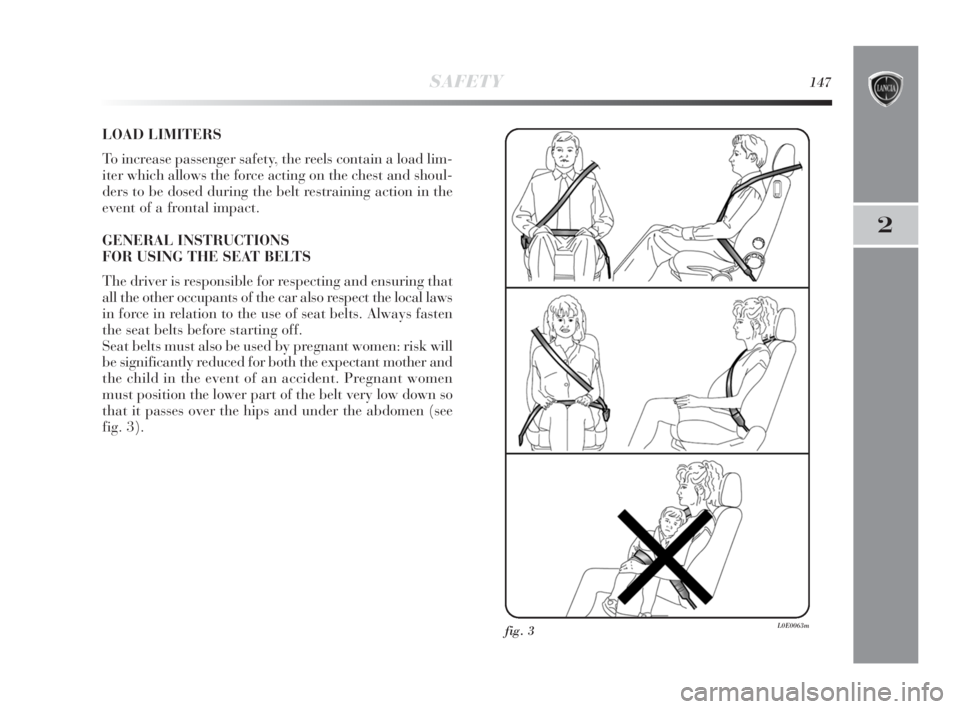
SAFETY147
2
LOAD LIMITERS
To increase passenger safety, the reels contain a load lim-
iter which allows the force acting on the chest and shoul-
ders to be dosed during the belt restraining action in the
event of a frontal impact.
GENERAL INSTRUCTIONS
FOR USING THE SEAT BELTS
The driver is responsible for respecting and ensuring that
all the other occupants of the car also respect the local laws
in force in relation to the use of seat belts. Always fasten
the seat belts before starting off.
Seat belts must also be used by pregnant women: risk will
be significantly reduced for both the expectant mother and
the child in the event of an accident. Pregnant women
must position the lower part of the belt very low down so
that it passes over the hips and under the abdomen (see
fig. 3).
fig. 3L0E0063m
143-164 Delta 4ed gb 12-02-2010 10:20 Pagina 147
Page 149 of 276
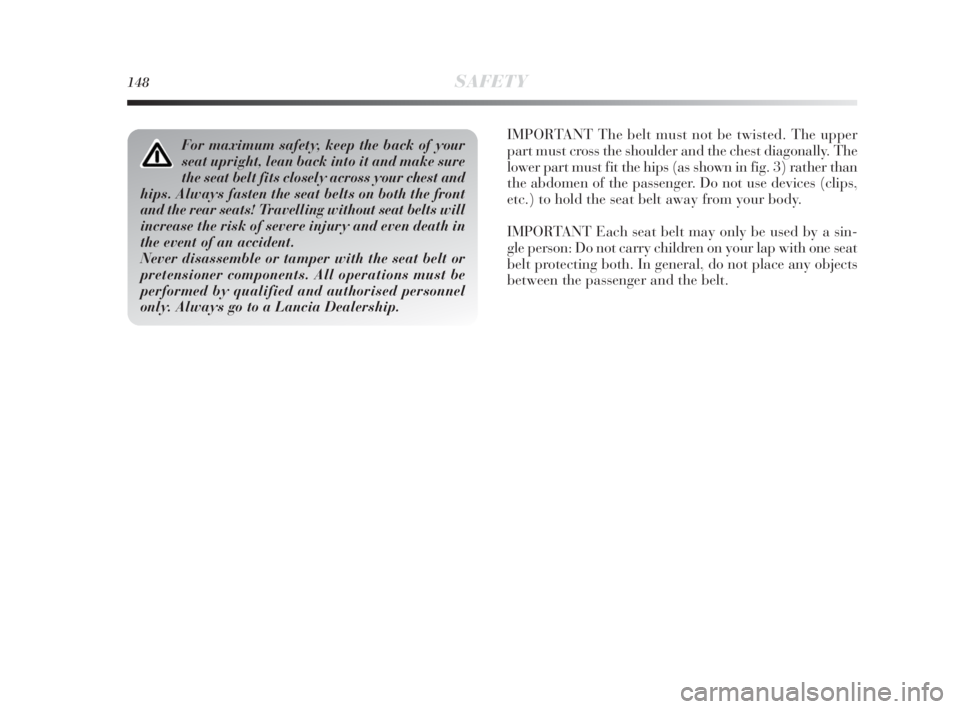
148SAFETY
IMPORTANT The belt must not be twisted. The upper
part must cross the shoulder and the chest diagonally. The
lower part must fit the hips (as shown in fig. 3) rather than
the abdomen of the passenger. Do not use devices (clips,
etc.) to hold the seat belt away from your body.
IMPORTANT Each seat belt may only be used by a sin-
gle person: Do not carry children on your lap with one seat
belt protecting both. In general, do not place any objects
between the passenger and the belt.For maximum safety, keep the back of your
seat upright, lean back into it and make sure
the seat belt fits closely across your chest and
hips. Always fasten the seat belts on both the front
and the rear seats! Travelling without seat belts will
increase the risk of severe injury and even death in
the event of an accident.
Never disassemble or tamper with the seat belt or
pretensioner components. All operations must be
performed by qualified and authorised personnel
only. Always go to a Lancia Dealership.
143-164 Delta 4ed gb 12-02-2010 10:20 Pagina 148
Page 150 of 276

SAFETY149
2
If the belt has been subjected to heavy stress,
for example after an accident, it should be
changed completely together with the an-
chors, anchor fastening screws and the pretension-
ers. Even if the belt has no visible defects, it may
have lost its resilience.SEAT BELT MAINTENANCE
Observe the following for correct seat belt maintenance:
❍always use the seat belts with the belt taut and never
twisted; make sure that it is free to run without im-
pediments;
❍replace the belt after a serious accident even if it does
not appear damaged. Always replace the seat belt if
the pretensioners were deployed;
❍to clean the seat belt, wash by hand with water and
mild soap, rinse and leave to dry in the shade. Do not
use strong detergents, bleach, paints or any other sub-
stance which could damage the belt fibres;
❍keep the reels dry: correct operation may only be en-
sured if the reels are dry;
❍replace the seat belt when it shows wear or cuts.
143-164 Delta 4ed gb 12-02-2010 10:20 Pagina 149
Page 152 of 276
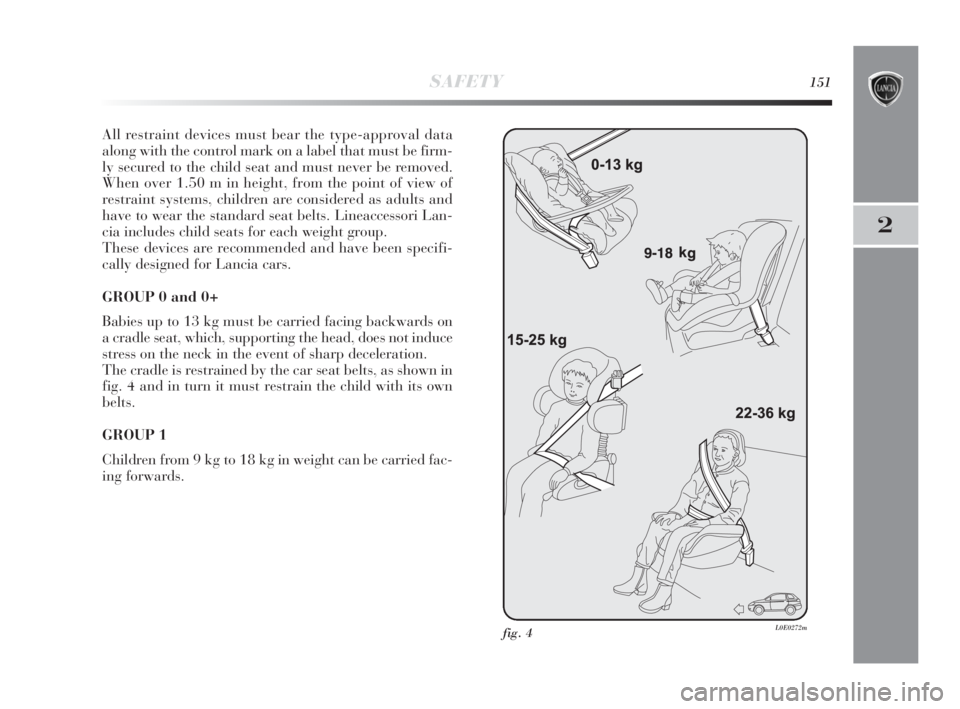
SAFETY151
2
All restraint devices must bear the type-approval data
along with the control mark on a label that must be firm-
ly secured to the child seat and must never be removed.
When over 1.50 m in height, from the point of view of
restraint systems, children are considered as adults and
have to wear the standard seat belts. Lineaccessori Lan-
cia includes child seats for each weight group.
These devices are recommended and have been specifi-
cally designed for Lancia cars.
GROUP 0 and 0+
Babies up to 13 kg must be carried facing backwards on
a cradle seat, which, supporting the head, does not induce
stress on the neck in the event of sharp deceleration.
The cradle is restrained by the car seat belts, as shown in
fig. 4 and in turn it must restrain the child with its own
belts.
GROUP 1
Children from 9 kg to 18 kg in weight can be carried fac-
ing forwards.
fig. 4L0E0272m
143-164 Delta 4ed gb 12-02-2010 10:20 Pagina 151
Page 153 of 276
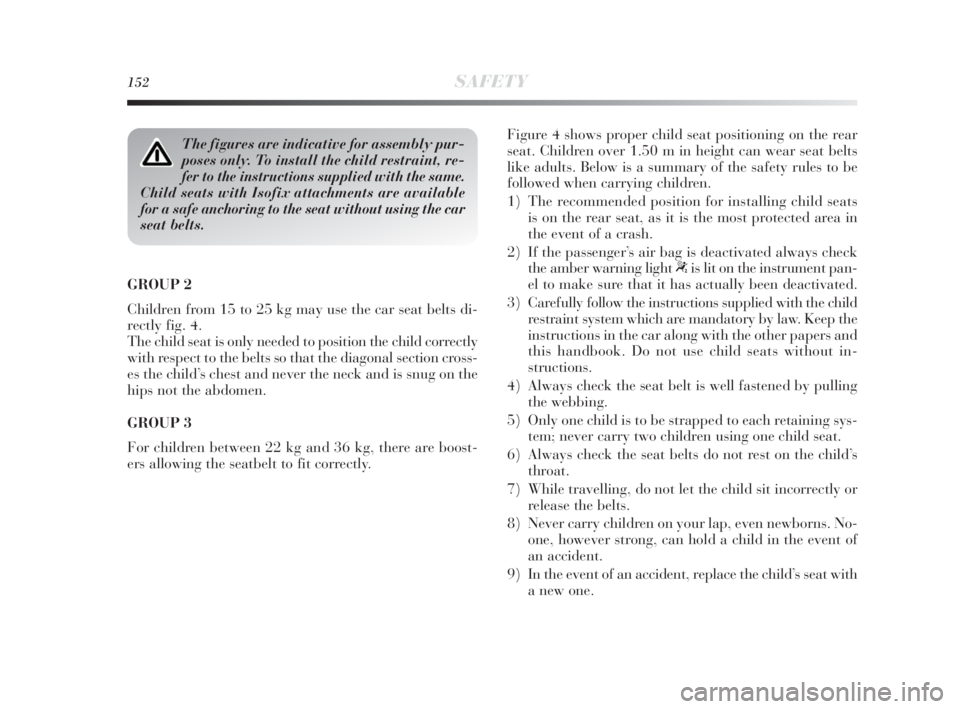
152SAFETY
GROUP 2
Children from 15 to 25 kg may use the car seat belts di-
rectly fig. 4.
The child seat is only needed to position the child correctly
with respect to the belts so that the diagonal section cross-
es the child’s chest and never the neck and is snug on the
hips not the abdomen.
GROUP 3
For children between 22 kg and 36 kg, there are boost-
ers allowing the seatbelt to fit correctly.Figure 4 shows proper child seat positioning on the rear
seat. Children over 1.50 m in height can wear seat belts
like adults. Below is a summary of the safety rules to be
followed when carrying children.
1) The recommended position for installing child seats
is on the rear seat, as it is the most protected area in
the event of a crash.
2) If the passenger’s air bag is deactivated always check
the amber warning light “is lit on the instrument pan-
el to make sure that it has actually been deactivated.
3) Carefully follow the instructions supplied with the child
restraint system which are mandatory by law. Keep the
instructions in the car along with the other papers and
this handbook. Do not use child seats without in-
structions.
4) Always check the seat belt is well fastened by pulling
the webbing.
5) Only one child is to be strapped to each retaining sys-
tem; never carry two children using one child seat.
6) Always check the seat belts do not rest on the child’s
throat.
7) While travelling, do not let the child sit incorrectly or
release the belts.
8) Never carry children on your lap, even newborns. No-
one, however strong, can hold a child in the event of
an accident.
9) In the event of an accident, replace the child’s seat with
a new one.
The figures are indicative for assembly pur-
poses only. To install the child restraint, re-
fer to the instructions supplied with the same.
Child seats with Isofix attachments are available
for a safe anchoring to the seat without using the car
seat belts.
143-164 Delta 4ed gb 12-02-2010 10:20 Pagina 152
Page 156 of 276
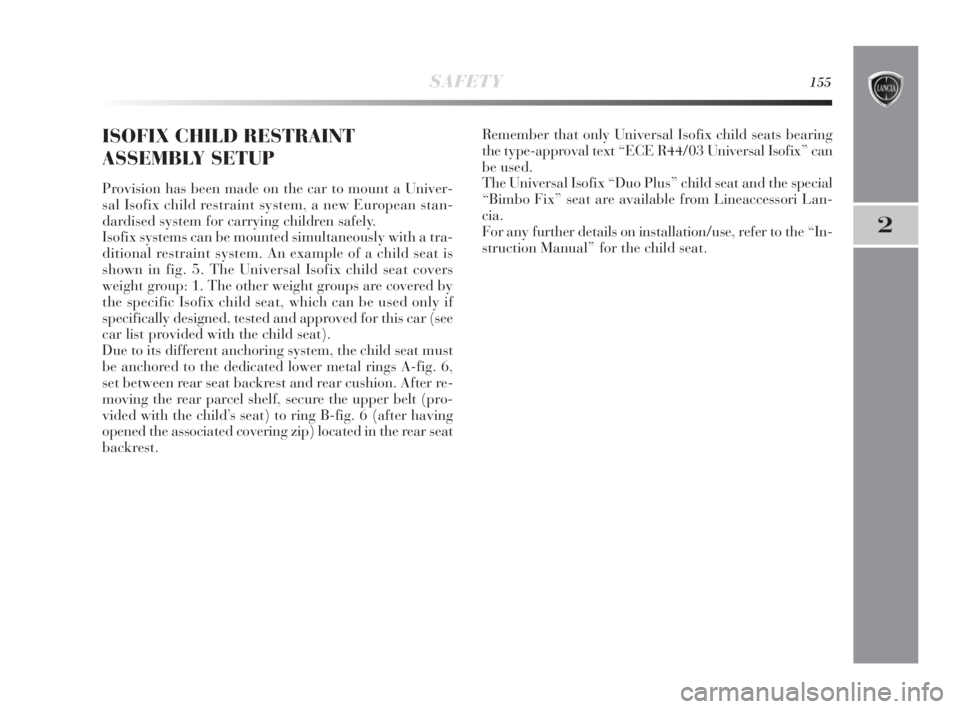
SAFETY155
2
ISOFIX CHILD RESTRAINT
ASSEMBLY SETUP
Provision has been made on the car to mount a Univer-
sal Isofix child restraint system, a new European stan-
dardised system for carrying children safely.
Isofix systems can be mounted simultaneously with a tra-
ditional restraint system. An example of a child seat is
shown in fig. 5. The Universal Isofix child seat covers
weight group: 1. The other weight groups are covered by
the specific Isofix child seat, which can be used only if
specifically designed, tested and approved for this car (see
car list provided with the child seat).
Due to its different anchoring system, the child seat must
be anchored to the dedicated lower metal rings A-fig. 6,
set between rear seat backrest and rear cushion. After re-
moving the rear parcel shelf, secure the upper belt (pro-
vided with the child’s seat) to ring B-fig. 6 (after having
opened the associated covering zip) located in the rear seat
backrest. Remember that only Universal Isofix child seats bearing
the type-approval text “ECE R44/03 Universal Isofix” can
be used.
The Universal Isofix “Duo Plus” child seat and the special
“Bimbo Fix” seat are available from Lineaccessori Lan-
cia.
For any further details on installation/use, refer to the “In-
struction Manual” for the child seat.
143-164 Delta 4ed gb 12-02-2010 10:20 Pagina 155
Page 159 of 276

158SAFETY
FRONT AIRBAGS
The car is provided with front air bags for the driver and
the passenger, driver’s knee air bag (for versions/markets,
where provided) and front side bags (side bags - window
bags).
The front airbags (driver’s, passenger’s, driver’s knee air
bags) have been designed to protect the occupants in the
event of head-on crashes of medium-high severity, by plac-
ing a cushion between the occupant and the steering wheel
or dashboard.
Front air bags are designed to protect car’s occupants in
head-on crashes and therefore non-activation in other
types of collisions (side collisions, rear shunts, roll-overs,
etc.) is not a system malfunction.
An electronic control unit causes the bag to inflate in the
event of a head-on crash.
The bag will inflate instantaneously placing itself between
the front occupant’s body and the structures which could
cause injury. It will deflate immediately afterwards.
The front airbags (driver’s, passenger’s, driver’s knee air
bags) do not replace but rather complement the seat belts,
which you are always recommended to wear, as specified
by law in Europe and most non-European countries.
In the event of a collision, a person not wearing a seat belt
may be thrown forward and come into contact with the
bag before it has fully opened. The protection offered by
the bag is reduced in such a case.The front airbags may not be activated in the following sit-
uations:
❍in collisions against highly deformable objects not af-
fecting the front surface of the car (e.g. bumper colli-
sion against guard rail, etc.);
❍car penetration under other vehicles or protective bar-
riers (e.g. trucks or guard rails);
in these instances they would not provide any additional
protection compared with the seat belts, so their deploy-
ment would be improper. Non deployment in such cases
does not constitute a fault.
Do not apply stickers or other objects to the
steering wheel, the dashboard in the passen-
ger-side airbag area, the roof side upholstery
or the seats. Do not place objects (e.g. cell phones)
on the passenger-side dashboard because these
could interfere with the correct opening of the airbag
and cause severe injury to occupants.
143-164 Delta 4ed gb 12-02-2010 10:20 Pagina 158
Page 160 of 276
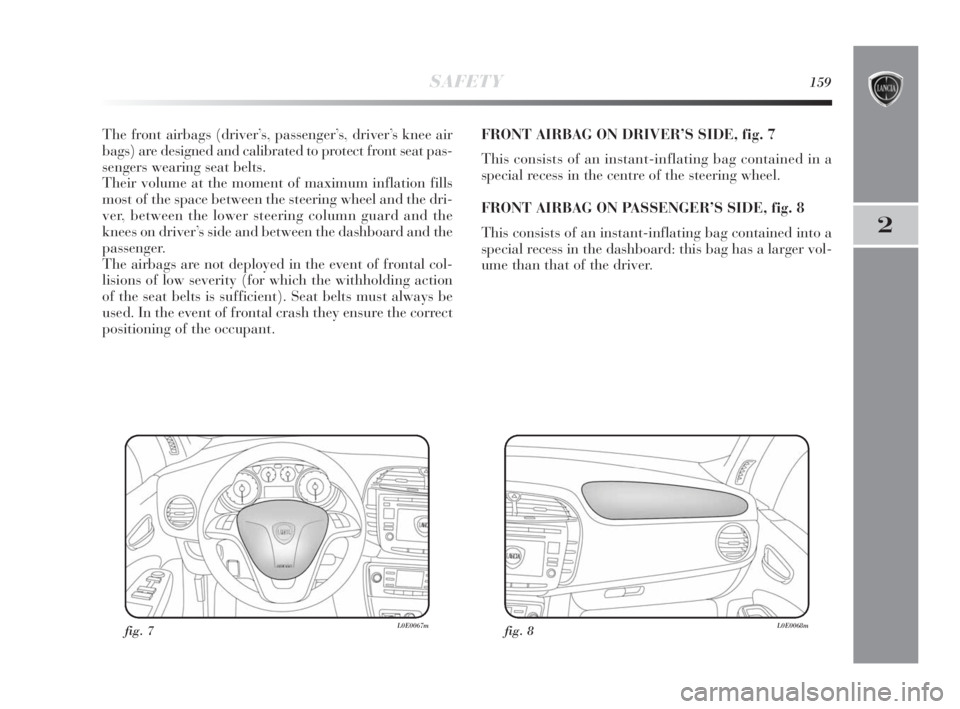
SAFETY159
2
The front airbags (driver’s, passenger’s, driver’s knee air
bags) are designed and calibrated to protect front seat pas-
sengers wearing seat belts.
Their volume at the moment of maximum inflation fills
most of the space between the steering wheel and the dri-
ver, between the lower steering column guard and the
knees on driver’s side and between the dashboard and the
passenger.
The airbags are not deployed in the event of frontal col-
lisions of low severity (for which the withholding action
of the seat belts is sufficient). Seat belts must always be
used. In the event of frontal crash they ensure the correct
positioning of the occupant. FRONT AIRBAG ON DRIVER’S SIDE, fig. 7
This consists of an instant-inflating bag contained in a
special recess in the centre of the steering wheel.
FRONT AIRBAG ON PASSENGER’S SIDE, fig. 8
This consists of an instant-inflating bag contained into a
special recess in the dashboard: this bag has a larger vol-
ume than that of the driver.
fig. 7L0E0067mfig. 8L0E0068m
143-164 Delta 4ed gb 12-02-2010 10:20 Pagina 159
Page 165 of 276

164SAFETY
With ignition key inserted and turned to
MAR, the air bags can activate even if the en-
gine is off and the car is at a standstill, if it
is hit by another vehicle. For this reason, children
must never sit on the front seat, even if the car is not
moving. We remind you that if the key is inserted
and turned to STOP, no safety device (air bag or
pretensioner) activates following a collision; non-
deployment in such cases is consequently not the
sign of a fault.
When the key is turned to MAR, the warn-
ing light “turns on, blinking for a few sec-
onds, to remind you that the passenger air
bag will activate in the event of a collision, then it
turns off.
Do not wash the seats with pressurized wa-
ter or steam (manually or at the automatic
washing stations).
The front airbags deploy in the event of more
severe collisions than those required for de-
ploying the pretensioners. For collisions in
the range between the two activation thresholds,
pretensioner activation is normal.
Do not hook rigid objects to clothes hangers
and support handles.
The airbag does not replace the seat belts, it
increases their effectiveness. Furthermore,
since front airbags are not deployed in low
speed collisions, side collisions, rear-end shunts
or roll-overs, the passengers are only protected by
the seat belts which must be fastened at all times.
143-164 Delta 4ed gb 12-02-2010 10:20 Pagina 164
Page 218 of 276
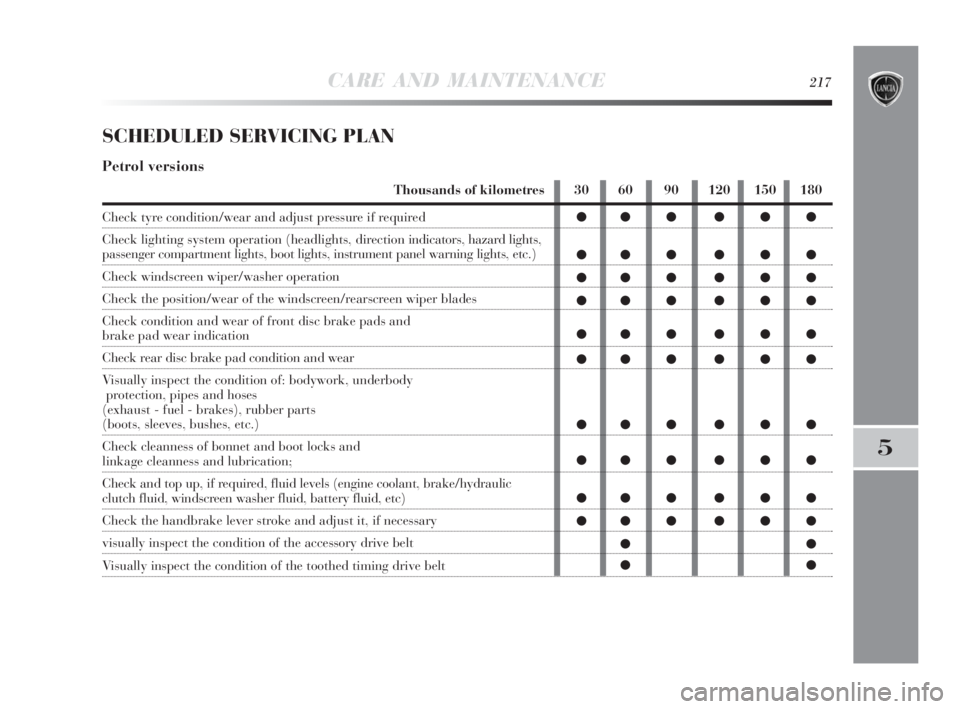
CARE AND MAINTENANCE217
5
SCHEDULED SERVICING PLAN
Petrol versions
Thousands of kilometres
Check tyre condition/wear and adjust pressure if required
Check lighting system operation (headlights, direction indicators, hazard lights,
passenger compartment lights, boot lights, instrument panel warning lights, etc.)
Check windscreen wiper/washer operation
Check the position/wear of the windscreen/rearscreen wiper blades
Check condition and wear of front disc brake pads and
brake pad wear indication
Check rear disc brake pad condition and wear
Visually inspect the condition of: bodywork, underbody
protection, pipes and hoses
(exhaust - fuel - brakes), rubber parts
(boots, sleeves, bushes, etc.)
Check cleanness of bonnet and boot locks and
linkage cleanness and lubrication;
Check and top up, if required, fluid levels (engine coolant, brake/hydraulic
clutch fluid, windscreen washer fluid, battery fluid, etc)
Check the handbrake lever stroke and adjust it, if necessary
visually inspect the condition of the accessory drive belt
Visually inspect the condition of the toothed timing drive belt30 60 90 120 150 180
●●● ●●●
●●● ●●●
●●● ●●●
●●● ●●●
●●● ●●●
●●● ●●●
●●● ●●●
●●● ●●●
●●● ●●●
●●● ●●●
●●
●●
215-242 Delta 3ed gb 11-11-2009 12:14 Pagina 217